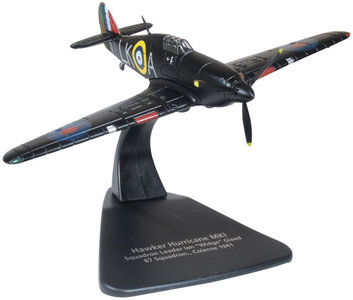A diminutive World War II fighter ace, a small but strategically placed RAF base in the quiet Wiltshire countryside and the valiant Hurricane MkI nightfighter are the background to this latest Oxford introduction on the Hawker Hurricane as it was deployed in 1941.
Ian Gleed, nicknamed Widge by his friends because of his small stature (5' 6 inches) and his favourite adjective 'Wizard', was born in 1916 in Finchley and educated at Epsom College. He learned to fly as a civilian and then joined the RAF where after officer training he was posted to 266 Squadron as a flight commander, flying Spitfires. Then in May 1940, he was posted to 87 Squadron, a Hurricane Squadron serving in France where, after a record number of enemy kills, he earned the reputation as being the fastest RAF pilot to make ace - in only two days. 87 Squadron was evacuated back to Britain in May 1940 to a Fighter Command air base in the West Country. From there the squadron took part in the Battle of Britain, flying Hurricane Mk I nightfighters to defend Bristol and Exeter. Gleed's success earned him promotion to squadron leader, taking command of RAF Charmy Down just north of Bath. His squadron spent a few months in 1941 at RAF Colerne, which was a satellite airfield for RAF Middle Wallop with squadrons flying back and forth on a daily basis. Due to the blackout, all attacks had to be made with the aid of searchlights into the sky.
It is in this brief 1941 period in Ian Gleed's career that our nightfighter Hurricane Mk I played such an important role defending strategic UK targets against the enemy. It is decorated in the black, dark green and dark earth nightfighter camouflage scheme with its LKA markings and RAF roundel on the fuselage and upper wings and vertical red, white and blue stripes on the tailfin. The cockpit is moulded in a muted green.
Shortly afterwards, Ian Gleed was promoted to Wing Commander centred at RAF Middle Wallop and organised fighter sweeps across the Channel and conducted bomber escorts. Still not satisfied, he obtained a posting to Tunisia and the North African Campaign. It was over Tunisia on 16th April 1943 that he was shot down and killed aged just 26, by a German flying ace. His final 'score' was thirteen enemy aircraft destroyed, seven probable, four damaged, one destroyed on the ground and one damaged on the ground. His battles included the Western Front, the Battle of France, the Battle of Britain and the North African Campaign and the Tunisian Campaign, during which he was awarded the DSO, DFC, Croix De Guerre (France) and the Croix De Guerre (Belgium). He was buried at Enfidaville, Tunisia.
Scale:
1:72
Dimensions: see
this page
Material: mainly metal
Stand: included
Brand: Oxford Aviation

Nr: AC105
In stock:
no
Added to website: 2024-06-03









